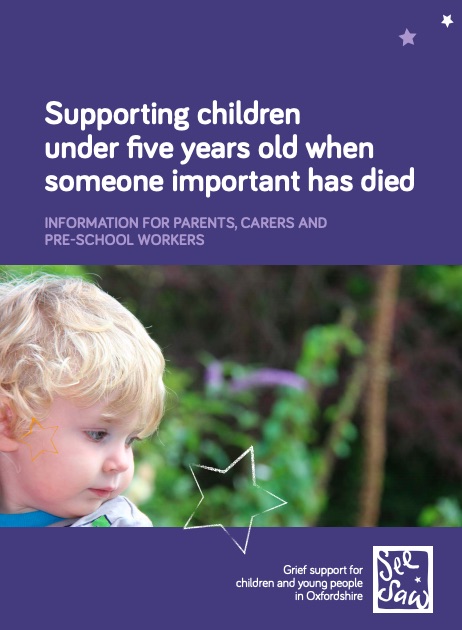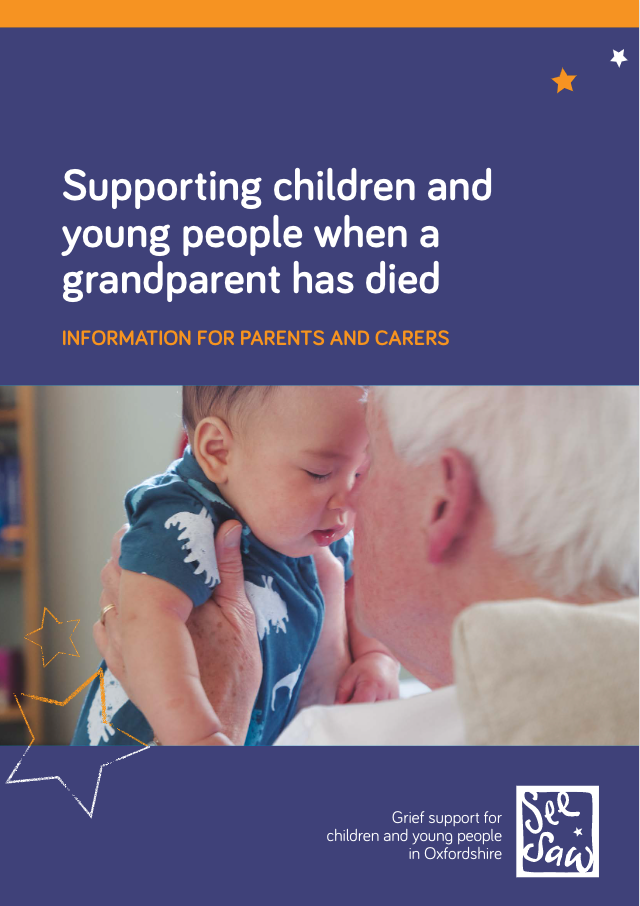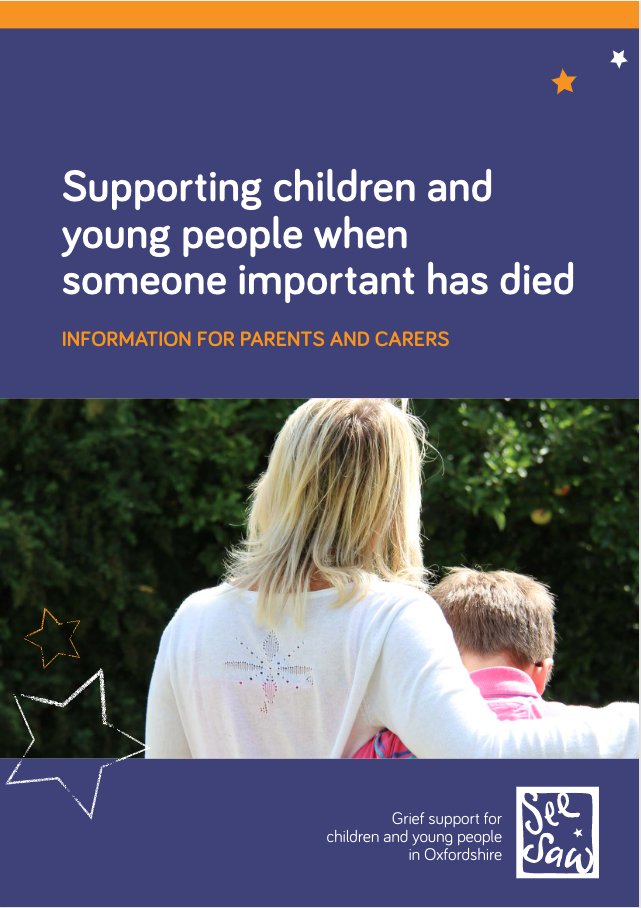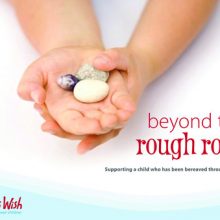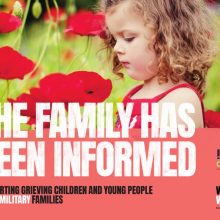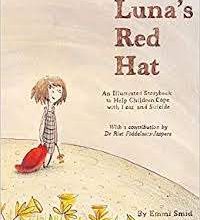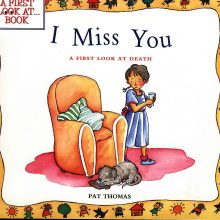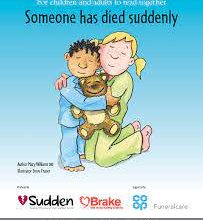Supporting bereaved children after a sudden death

A death of any kind is an incredibly painful experience, but when a death has been sudden it can cause additional anguish and confusion.
We have written some advice on how to support children and young people who have been bereaved by a sudden death. We have separated the information into the categories below.
We have separated the information into sections as a lot of information at once can feel overwhelming. We recommend you read a section at a time, particularly the sections on ‘Explaining death to children’.
Bereavement by suicide or possible suicide
Impact on families
The death of someone important is an incredibly difficult event whatever the cause of death. However, for families bereaved through suicide there are often additional pressures and challenges.
Death by suicide can result in families finding the grieving process more complex and complicated than other bereavements. Although the grief may be like that of any other kind of death, the suddenness and shock of a death by suicide can be acutely distressing, confusing and grief can feel more intense and longer lasting. Families are often left with unanswered questions which can be confusing and hard to process. For some there is still a stigma attached to suicide, where it is seen as a crime or a sin. This can make it difficult to talk about with others and be very isolating.
There will be differences for all members of the family depending on who dies. The death of a parent or a brother or sister or of a partner or child will impact differently on children and adults depending on the previous relationships.
Common thoughts and feelings
Children will react to any death in accordance with their age and stage of development. Click here to read more about how this affects their reaction.
Below are some common reactions experienced by those who have been bereaved by suicide. These feelings are not definitive and may not be experienced by everyone. It is unlikely that very young children will experience these reactions.
Numbness, shock and disbelief
By its very nature, suicide is often untimely, unexpected and may be violent. Sometimes a death through suicide comes out of the blue to those close to the person who has died. Even if someone has said they plan to end their life or has attempted to do so before, the death will still come as a shock and it can take a long time to accept it has happened. However, the feeling of numbness at the beginning can often protect from feelings which may seem overpowering and may in fact help you get through the early days when there is too much to cope with.
Guilt, anger and even relief
Guilt and anger are common reactions in bereaved people but tend to be felt more intensely and for longer by relatives and friends of people who have died by suicide. You may feel guilt that you are alive and that you didn’t or, indeed, couldn’t prevent the suicide.
You may be angry for being left behind to cope. You may find it impossible to ‘switch off’ the last conversation. This is difficult enough if your last conversation with the person seemed cheerful and normal; it is more difficult if your last conversation was an angry or hurtful one.
Some people may feel a sense of relief, especially if there have been frequent suicide attempts, violence, or if your family life has been dominated by one emotional crisis after another. However, even this relief can be brief and swamped by feelings of guilt for having felt relieved.
Rejection and betrayal
Family members can often feel rejected by someone who has taken their own life. Relatives and friends may be left asking ‘Why did he or she do this to me?’ ‘Did I fail them in any way?’ ‘What have I and the children done to deserve this?’ When time has been spent supporting a child or partner with depression it might feel all as though these efforts have been rejected. Some may feel as if their love has also been rejected.
Shame and blame
Suicide is no longer a crime but there is still stigma associated with it. The legal framework that surrounds an investigation and inquest can make families feel on trial. Families may feel that neighbours, work colleagues or even other members of the family are questioning the death in a way they never would if the death had been through an illness or accident. Relatives may be desperate to understand what has happened and, in trying to make sense of everything, they may try to put the blame on to someone other than the person who died. This is even harder when feelings of self-blame are already apparent.
One of the particularly hard feelings is shame; adults often feel that there is a strong sense of shame attached to a death by suicide and they try to protect their children from this feeling. In fact, younger children do not experience shame in the same way as adults do when someone has taken their own life. They may well be blaming themselves and possibly others, but shame is not such a common reaction. Adolescents may feel shame, having developed a more mature understanding of suicide, and being particularly sensitive to the judgements of others.
Explaining death by suicide to children
It is a natural instinct to want to protect children from upsetting news and so it is common that people are tempted to give a different explanation in the case of death by suicide. When someone has taken their own life, it is common that the bereaved family will have to cope with the circumstances of death becoming very public. There will also be visits from the police, there may be media interest and conversations about the death taking place within the community and on social media. Because of this, it is likely that children and young people will come across information about the death by over-hearing conversations or from other people. The possibility of this is increased with children's access to the internet, where information may be available for years to come. It is generally best to try to be open and honest with children from the start so that children do not find out the truth by accident or hear something that is not true.
These conversations may feel impossible but hearing this news from a parent can provide an opportunity for them to have clear, child appropriate answers and be reassured that they are not to blame. It is important to try and avoid secrets and unnecessary details. If possible, a parent/carer is generally the best person to tell their child this difficult news. However, if this is not possible, it is important they try and be present while someone else delivers the information.
It can help even very young children to have a simple story that they can use to re-tell and slowly make sense of what has happened. Use words they understand. Always ask them what they think about what you have said to make sure that they have understood.
Events surrounding suicide can often become very confused. Facts may be changed to become more comfortable to live with or to make them easier to explain. Try to be consistent in your explanations to the children, telling them honestly what you believe to be true.
It may be that you have already given your child a different explanation for the death than suicide. If this is the case, it is ok to go back and explain things again. You could try something like this:
‘You know I told you that Daddy died and that he died from a heart attack? Well, I’d now like to tell you a bit more about it. When Daddy died it was hard for me to explain exactly what happened, but now I’d like to tell you more about how your Daddy died’.
Older children may feel hurt to have been protected from the full facts before. In these circumstances it can help to say something like:
‘I have been impressed by how you’ve been since Mum died and I think you’re mature enough to know some more about what happened when she died.’
Knowing what to say
Winstons Wish suggest there may be five stages involved in telling a child that someone has died by suicide. These five stages may happen in the space of minutes, hours, days, weeks, months or even years. The pace between the stages is often led by the child’s needs and ability to understand which is in turn affected by their age and developmental understanding. The pace will also be affected by the situation, for example, the possibility of your child finding out what has happened from other sources or from older members of the family.
This process takes time. It needs to be handled with care, giving the children the chance to say how they are feeling. You may want to ask your child if they would like to know more details and then be guided by their response. If a child says they don’t want to hear more just now, they need to know that they can come back to you for more information. Then again, you may feel that your child cannot handle any more information at the moment. It is important then to tell your child that you will tell them more on another occasion – and to do this.
Our experience indicates that if a child asks a question about what has happened, they are ready to hear the answer.
We have put some further information together for each stage: This is the stage when you explain gently and simply that someone has died. It is helpful to do this somewhere the child feels comfortable and safe. Older children may need space to themselves afterwards, so being close to a place they can go to on their own, such as their bedroom, is useful. It is important to avoid euphemisms such as 'gone to sleep' 'gone to the sky' as this can cause confusion. Although it might feel uncomfortable, it is important to use the words died and dead. Try to give them a simple, short, honest sentence: ‘I have something really sad to tell you. Mum died today.’ The second step provides a little bit more information by giving an explanation about how or where the person died. This allows you to be honest without giving details you may feel are not appropriate. Giving these simple details allows the child to place the death within a context in their head which can be added to as time goes on. When children are not given honest information, they tend to fill in those gaps with their imaginations, which can result in confusion and complications later. Here are some examples: ‘Mummy died up on the hill by the trees.’ ‘Grandad died in the car.’ ‘Daddy died because he took more of his tablets than he should have.’ ‘Alisha died by the railway line.’ ‘Hassan died because he got very badly burnt.’ The next stage is to explain that it was the person’s choice to take their own life. This can be a very difficult thing to explain to a child, but our experience shows that being given this truth in a child- appropriate way is important and prevents them from discovering this information from someone or somewhere else. You can start by asking to give them some more information, ‘ I would like to give you a bit more information about how Daddy died.’ Then you can explain that sometimes people choose to end their life, ‘There are lots of reasons that people can die, most people don’t die until they get very old, but sometimes people die from illnesses or accidents. Sometimes people choose to hurt themselves and they die. This is what Mummy did’ After your conversation, you might want to ask the child again if they want any more information, which might be a good opportunity to introduce the word ‘suicide’. They are likely to come across this word at some point and if they hear it being used to describe what happened to their loved one, without knowing what it means, it can cause confusion. ‘When people do something like this, they are often very sad and confused and think it is the best thing to do. It is called ‘suicide’ or ‘ending your own life’. The next step is to give more detail about the method of suicide. This is often the part most people worry about and want to protect children from. This understandably feels counterintuitive and uncomfortable, however if the information is given in a simple, gentle, honest and age appropriate way it often helps children fill in gaps in their story of what happened. When these gaps are missing children are likely to fill them with their own imagined thoughts which can cause more distress. Here are some examples you could use for different methods of suicide. Suicide by hanging ‘ Do you remember how we say to never put anything around your neck because it’s dangerous? Well Daddy went to a quiet place in a field and took some rope with him. He tied one end of the rope around his neck and the other end to the tree. He climbed up the tree and then jumped off. When he jumped the rope pulled very tight and it stopped him from being able to breathe. This is how he died’ ‘When the doctor gives us medicine to take it is to make us feel better, but if you take more medicine than the doctor has told you it can make you very poorly. Mummy took too many tablets at one time. When you take too many tablets it makes your body very poorly and is too hard for your body to stay alive and you die. This is how Mummy died.' The above explanation can be adapted as in:- ‘……Mummy took too many tablets at the same time and then she drank a lot of wine. When you take too many tablets and drink lots of alcohol together, it is hard for your body to stay alive………’ 'David walked down to the railway line and he stepped in front of the train when it was coming towards him. The train was very fast, and it did not have time to stop. It hit David. His body was very badly hurt, and he died straight away’ 'Ishmael parked his car where no one would notice. He put a tube in the exhaust pipe that comes out of the back of the car. He put the other end of the tub inside the car. When a car’s engine is running it makes fumes come out of the exhaust. Ishmael sat inside the car and turned the engine on. This meant that all of the fumes came into the car and there was not enough Oxygen, which is what we need to breath. These fumes are poisonous and if you breathe a lot of them in you die. It is not painful, Ishmael would have become sleepy and eventually died because his body couldn’t live without Oxygen.’ ‘Jane went to the top of the building which is very high up and she jumped off. It was so high up that the fall hurt her very badly. When your body has been hurt that much you die and that’s how Jane died.’ ‘Josh took a can of petrol and poured it all over himself. He then lit a match and set the petrol on fire. The petrol burnt him very badly and he died. The doctors have said that Josh died very quickly, and although it would have hurt, it would have only hurt for a short time before he died.’ There are other ways people die by suicide and these can be adapted from the suggestions given here. It is important to try and balance the information you give with some reassuring and comforting words, such as ‘Daddy loved you very much and nothing you did or didn’t do made him do this’ ‘Mummy didn’t want to hurt you, she loved you very much’ It is important to check what the child has understood after one of these explanations. They should feel informed without feeling too frightened. One of the hardest things about death by suicide is that there will always be unanswered questions. No-one can every fully know the reasons someone chose to end their life. It is important though, that children know that nothing they said/did/ could have said/done made it happen. The suggestions below could be adapted to help you give some explanation of why someone took their own life, ‘Sometimes people can feel so sad that they believe things that are not true. Sometimes they might believe that the people around them would be happier if they were not here anymore. This isn’t true, but it’s what they believed and so they decided to stop living. This might be what happened with Daddy’ ‘Sometimes people can have an illness in their brain that makes them feel very sad and confused. Doctors can give medicines to help this, but Mummy didn’t go to the doctors. When people feel this way, they can think that the only way to stop feeling so bad is to stop living. This might be why Mummy decided she wanted to die.’ ‘People often have problems in their life, but sometimes these problems can build up and feel like they are too much and that there is no way to escape them. Sometimes, instead of asking for help people can feel that the only way they can get away from the problems is to end their life. This might be why Janie decided to end his life’ ‘We don’t understand why Jack decided he wanted to die. Sometimes someone can seem very happy on the outside but be feeling different thing inside. Unfortunately, sometimes people feel that they can’t talk to people about the feelings they have and instead these feelings can become too big and they might feel the only way to stop these feelings is to die. We will never know exactly what Jack was thinking, but we do know that he loved us, and he didn’t want to upset us.’ Stage 1. Explaining that the person has died
Stage 2. Giving simple details about how the person died.
Stage 3. Saying that the person chose to end their own life
Stage 4. Providing a more detailed description of how the person died
Suicide by overdose
Suicide by overdose and alcohol
Suicide by jumping in front of a train
Suicide by carbon monoxide poisoning
Suicide by jumping
Suicide by burning
Other situations Stage 5. Exploring possible reasons why the person chose to end their life
Find time to talk
It can be difficult to find the opportunities to talk; this can be particularly true if the death occurred some time ago. You could use opportunities provided by news events, stories, TV programmes, anniversaries or a further family death to talk more about the person who died. Try to visit the grave, garden of remembrance or other special place and talk about the person who died. Also try to keep in contact with friends and family: it is easy to lose contact, especially if you feel people are still feeling guilty or blaming each other.
Children may raise the subject when you are least expecting it, but try to stay calm and take time to listen to what they are saying and asking. If it is not an appropriate time to talk, let them know that this is something that is important to you and set an appropriate time to talk about it.
Being in the public eye
The death of a family member by suicide means that grief can be made very public. As well as the funeral, families also have to face an inquest which can be stressful. The full inquest may not be held until months later. This delay can be difficult for families and many feel that they can’t begin to grieve properly until the inquest has taken place. It can also be painful to have the person who has died discussed by strangers or referred to in newspapers or on social media.
It can help to
- Try and avoid looking at articles about the death
- Be aware of what is accessible on the internet so that you are prepared for what children may be able to access.
Talking to other people
Death is still a difficult issue for many people to discuss and a death by suicide is probably one of the hardest things to explain or talk about, especially if it is at a time when you are not prepared.
Thinking in advance about some answers to questions that could come up should make them easier to deal with. Here are a few suggestions:
‘I’m sorry to say that he killed himself – we’re still struggling to understand why.’
‘Jasmine felt she couldn’t go on living anymore and so decided to end her life.’
‘Isaac seems to have felt that suicide was his only choice, which is very painful to think about’
Answering difficult questions
It is helpful to encourage children to ask questions. This will help to find out what they are thinking and how they are dealing with the death. If you don’t know the answer to a question, it’s ok to say so and reassure the child that it was not a silly question to ask. Sometimes it can help to think ahead about questions that might get asked and then practice answers you are happy with.
It might help to ask the family doctor to answer specific medical questions so that the whole family can understand why the person’s actions made them die (for example, how does exhaust gas make you die) and also what sort of death it would have been. With a violent death, it is reasonable to assume that there would have been some pain or suffering. While it is difficult to talk about this, not talking does not stop a child worrying about it or imagining worse than the reality. Some reassurance that the death was quick, and any pain of very short duration can help children deal with difficult facts.
Below are some suggestions that can be used for different types of questions:
Sometimes children ask whether they could have done anything to change what happened or if it is their fault the person died. This needs explaining because children, particularly younger children, often feel they have some sort of power over the people and events that matter to them.
‘Sometimes no matter how good we are or what things we say or do, if someone feels so bad that they want to end their life, there’s nothing we can do to stop them.’
‘Lots of us have wondered if we did something or didn’t do something to make them want to end their life – we’ve worried that it might have been our fault. But if someone feels very down about things and decides to kill themselves, then they’ve made the choice about what they want to do. It’s no-one else’s fault – it’s their decision.'
'The sad thing is that sometimes people make that decision when they are feeling useless and don’t like themselves much. I wish they’d realised they were important to us and didn’t need to do this.’
The most important thing to stress is that the person did not die because they no longer loved their child.
‘Whatever Mum was thinking, the one thing I know for sure is that she loved you with all her heart. She would never have done anything to hurt you.’
Children may worry about their other relatives doing the same thing.
‘I won’t do the same thing. Like you, I have felt very, very upset and low since Jim died but I know that I will never choose to die like Jim. I know what it’s like for those left behind after a suicide. At the moment, I still need to be sad and I will probably need to be sad and maybe angry for a long time. That doesn’t mean I will kill myself.'
Where to get further support
Child Bereavement UK - support for bereaved families
Helpline 0800 02 888 40
Samaritans – confidential emotional support for anyone in a crisis – 24 hours a day Phone: 08457 909090 Textphone: 08457 909192 Email: [email protected]
The Compassionate Friends – support for bereaved parents who have lost a child of any age and from any circumstance
Phone: 0845 123 2304 Email: [email protected]
Survivors of Bereavement by Suicide – local self-help and support groups for those bereaved through suicide
Phone: 0870 241 3337
Bereavement by homicide (murder or manslaughter)
Common thoughts and feelings
Children will react to any death in accordance with their age and stage of development. Click here to read more about how this affects their reaction.
As with any death, people will experience grief in their own time their own way and while there may be similarities, a death that has been sudden and violent can mean that these feelings are experienced more intensely. Below are some common reactions experienced by those who have been bereaved by murder or manslaughter. These feelings are not definitive and may not be experienced by everyone and it is unlikely that very young children will experience these reactions.
Numbness, shock and disbelief
By its very nature, death by murder or manslaughter is unexpected and may be violent. Any death that comes as a shock can take a long time to be fully processed and accepted as reality. This can be particularly difficult for children who may not know the details of the death. However, the feeling of numbness at the beginning can often protect from feelings which may seem overpowering and may in fact help in the early days when there is a lot to cope with.
Guilt
It is common after someone has died by murder or manslaughter for family and friends to question whether there was something they could have said or done that might have prevented the death from happening. For example, some might think that if they had insisted on their loved one staying in with them instead of going out, it may have been avoided. This can lead to feelings of guilt which can add to the already immensely painful feelings of grief.
Fear
When someone has died by murder or manslaughter it can inevitably make the world seem a much scarier place for their loved ones. This fear can lead to people not wanting to leave the house or do normal activities. This can be particularly difficult in cases where the perpetrator has not yet been found.
Blame and Vengeance
With any death, it can be common to experience the need to blame someone or something. In cases where someone has died by murder or manslaughter there will be a particular person(s), or institution, who will be held responsible for the death, and therefore the feelings of blame may be intensified. In such cases, blame can lead to feelings and expressions of vengeance, where the bereaved family or friends wish ill on the perpetrator as a way of finding justice for the deceased.
Factors involved in bereavement by homicide
Any death is painful to experience, however with a death by murder or manslaughter there are additional factors which can add to and intensify a bereaved person's experience. We have listed a few of them below.
Media Attention
It is likely that a death of this kind will be picked up by local or national press. It is also likely that it may be shared across social media platforms, resulting in additional comments from strangers. This type of attention can be very intrusive, particularly if the press are keen to speak with friends and relatives. Children may find it particularly hard to deal with this kind of intrusion if staff and pupils at their school are talking about what happened.
Investigation
As with any crime, there will be an investigation into what happened. Although this is an important necessity in finding answers, the process of an investigation may be a lengthy one and the pressure of dealing with the various elements can bring additional stress and potentially delay or complicate grieving. It can also be challenging for families as they try to protect children from the details of these proceedings.
When the perpetrator is known
If the perpetrator is a family member this can cause a range of mixed and conflicting emotions. For children who may have had a close relationship with the perpetrator they will be dealing with the confusion of having love for the person, mixed with the negative feelings about what they have done. For very young children who may not fully understand what has happened, they may continue to ask to see the perpetrator or say they miss them, if they were a significant part of their life.
Where a parent has been killed by the other parent, on top of the emotional confusion there will be the additional complications of who now looks after the children as neither parent will now be present.
How to tell children someone has died by murder or manslaughter
Breaking this news can understandably feel very difficult and it is natural for adults to want to protect children from the truth. However, with the right support, children are often able to cope with the truth of what has happened very well. In cases where there is likely to be a lot of attention on the death, it is easy for children to over-hear what happened from other people which can cause difficulties if this does not match up with what they have been told by a trusted adult.
It can be helpful to break the news in small sections. For some children you may cover all of these sections in one go, for others it may be more spread out. We have set these out below.
Explaining that someone has died
If possible, try and break this news somewhere that is comfortable and feels safe for the child. It can be helpful, particularly for older children for them to have a safe place close by (such as their bedroom) where they can go to after this news if they need some space.
Give very simple information which explains that the person has died. You don’t need to go into any details just yet. You could use words like this:
“I have some very sad news to tell you, Mummy died last night”
If you think they may have heard other information, it can help to ask them what they think has happened so that you can pick up any facts that need correcting.
Giving simple details
This level of information helps a child to place what has happened within a context so that they have somewhere to form the rest of the information as they are given it. Give honest simple details such as where they died. For example:
“Jane died near the youth centre in town” “Daddy died outside the train station”
Explaining how they died
Giving honest details is helpful for children to process what has happened, and to make sure they do not base what happened on over-heard conversations or on their own imagination as this can often be worse. However, it is important to think about how this information is worded so that is appropriate for the child's age.
Particularly with younger children, try to use words that are less emotive. Instead of ‘shot’ and ‘murdered’ use words such as ‘hurt’ and ‘killed’. Try and combine simple truths with words of reassurance.
“Somebody hurt Mummy badly. The doctors tried to help her, but her body was too hurt and she died. The doctors were able to help so Mummy wasn’t in any pain when she died”
“Carl was in a fight with some people and they hurt him with a knife and his body was so hurt that he died. The police are going to do everything they can to find who did it, and we are safe here.”
Try to avoid saying things like ‘a very bad/mean man did it’ as this can be quite frightening for a child. Instead try saying that someone did a very bad thing.
It’s important to check that the child understands what they have been told by asking them once you have explained what has happened. Younger children do not have the same understanding of what death means as older children, so you may need to go through this with them in language that is appropriate for their age. We would recommend books such as ‘I miss you, a first look at death’ by Pat Thomas and ‘Lifetimes’ by Bryan Mellonie and Robert Ingpen to aid these conversations.
Remember that children will understand and react to what has happened in accordance with their age and stage of development. For example, a younger child may repeat the same question again and again, even if you have given them the same answer consistently. This is how they process the information, and although it can be difficult to keep repeating the answer, it is an important task in them developing their understanding. For more information on this look through the relevant categories on the Help for Families page
Answering Questions
At each of these stages you can ask if the child has any questions. These questions will help you know what they feel ready to hear. Try to answer their questions honestly, but again only with the details they need and using words that are appropriate to their age.
They may ask questions which you either don’t have the answer to, or you are not ready to answer. It is ok to say that you don’t know, or that you want to answer their question but not right at that moment. If you don’t want to answer a question at the time, it’s important to say when you will sit and talk with them about it so that it doesn’t get forgotten.
What can help
To have an idea of what can help children at different ages and stages of development, visit the relevant pages on our ‘Help For Families’ page.
Reassurance
For children bereaved by murder or manslaughter the world can now seem like a scary place. Children need a lot of repeated reassurance that they are safe and loved. It is important to remind them more that once that nothing they did could have caused or prevented what happened as this can take some time to sink in. Try to remind children of the good in the world and that although some people are not kind and do bad things to hurt others, the majority of people are good and treat people with kindness. If there is a lot of negative news in the media, try to look for local stories with positive messages or point out times where someone treats you / them with kindness.
Explain key information
With a death by murder or manslaughter there is likely to be a lot going on and different professionals visiting. If there are professionals who are having regular contact with the family, it can be helpful to explain who they are and what their job is. It might be that some professionals will need to talk to the children, so knowing who they are and why it is they want to talk with them in advance can put fears at ease and help them feel prepared and in control. Try and use simple language in these descriptions and explain that these people are trying to find out what happened so that the same thing doesn’t happen to others.
Giving control
There is often a sense of feeling out of control when someone has died by murder or manslaughter. This can feel scary for children and so providing them with tasks where they get to make decisions can enable them to feel in control again, even if in a small way. This can be done by involving them in decisions being made such as funeral arrangements – which flowers or songs to choose, having the option to say or write something for the funeral etc. It can also be done in the small everyday decisions such as what to have for dinner. Sometimes making decisions can feel overwhelming, so it might be helpful to provide just a few options to choose from.
Encourage normality and fun
It is normal and healthy for children to dip in and out of their grief; one minute they may be sad and saying how they miss their loved one, and the next minute they are laughing and playing. This is often referred to as ‘puddle jumping’ and it can feel uncomfortable for adults who worry that if a child is happy and playing it means they are not grieving. However, it is an important part of healthy grief for children to engage in normal activities and to have fun with their friends. As children get older, they may feel a sense of guilt for having fun and doing normal things. It’s important to let them know that it’s ok to still have fun and laugh, it doesn’t mean that they no longer care about, or have forgotten their loved one.
Model open and honest grief
It is a natural instinct to want to shield and protect children from upsetting things, and so many adults try their best to hide their own grief from their children and save it for when they are out or in bed. However, children look to the adults around them for their learning in all sorts of situations, particularly around how to react to life events. This is no different with grief; they will be watching to see how the adults around them are reacting and will take this as what is normal and expected of them too. If they only see people putting on brave and happy faces and never showing their sadness, they will believe that this is how they should behave. This can mean that their true feelings can get pushed down instead of being shared. It is helpful to model grief in your own reactions, but it is also important to explain them to children. For instance, it’s ok to cry in front of children but explain to them why and reassure them that it is not anything they have done; “Mummy is crying because she misses Daddy and that makes her feel sad. It’s not because you have done anything wrong.” Sharing your emotions also gives space to encourage children to share their emotions with you; “It’s ok to cry if you feel sad, but it’s also ok to feel lots of different things – how do you feel today?”
Other organisations who can help
Child Bereavement UK - support for bereaved families
Helpline 0800 02 888 40
The Compassionate Friends – support for bereaved parents who have lost a child of any age and from any circumstance
Phone: 0845 123 2304 Email: [email protected]
SAMM - Support after murder and manslaughter
Helpline: 0121 4742912 Email: [email protected]
Victim Support - Support for those affected by homicide.
Homicide service: 0300 303 1984 Request support online
Accidental death
Common thoughts and feelings
Children will react to any death in accordance with their age and stage of development. Click here to read more about how this affects their reaction.
As with any death, people will experience grief in their own time their own way and while there may be similarities, a death that has been sudden can mean that these feelings are experienced more intensely. Below are some common reactions experienced by those who have been bereaved as the result of an accident. These feelings are not definitive and may not be experienced by everyone and it is unlikely that very young children will experience these reactions.
Numbness, shock and disbelief
By its very nature, an accidental death is unexpected and may be traumatic. Any death that comes as a shock can take a long time to be fully processed and accepted as reality. This can be particularly difficult for children who may not know the details of the death. However, the feeling of numbness at the beginning can often protect from feelings which may seem overpowering and may in fact help in the early days when there is a lot to cope with.
Guilt
It is common after someone has died in an accident for family and friends to question whether there was something they could have done that might have prevented the death from happening. For example, some might think that if they had insisted on their loved one staying in with them instead of going out, it may have been avoided. This can lead to feelings of guilt which can add to the already immensely painful feelings of grief.
Fear
When someone has died as the result of an accident it can inevitably make the world seem a much scarier place for their loved ones. Children may feel that a world that previously felt safe and secure now feels unpredictable and frightening. This fear can lead to people being anxious about performing routine daily tasks, particularly those that are connected to the way their loved one died, such as driving for example.
Blame
With any death, loved ones often experience the need to blame someone or something. If the accident that caused the death was the result of someone else’s actions, it is common for blame to be directed at them as a way of satisfying a need for justice on behalf of the deceased.
Factors involved in accidental death
Any death is painful to experience, however with an accidental death there are additional factors which can add to and intensify a bereaved person's experience. We have listed a few of them below.
Media Attention
When an accident results in a death it is often picked up by local and sometimes national press. This can mean that families might come across articles about their loved one without warning, or they may be approached by journalists. This can be very difficult to face on top of the existing pain and shock of a death.
Investigation
When a death has happened due to an accident it is common that there is some form of investigation or inquest. Although this is an important necessity in finding answers, the process of an investigation may be a lengthy one and the pressure of dealing with the various elements can bring additional pressure and potentially delay or complicate grieving. It can also be challenging for families as they try to protect children from the details of these proceedings.
Social Media
If an accidental death is picked up in the local press, it is very common for it to end up on social media sites. This can cause difficulties as information may be based on hearsay rather than facts. Families can find this distressing especially if the investigation has yet to provide conclusive evidence about what happened.
When the child witnessed or was involved in the accident
If a child is present at the time of an accident, depending on the circumstances, they are likely to react to what they have experienced as well as their grief. This can result in a variety of emotional reactions and in cases where there has been significant trauma, they may need specialist support to help process their experience. Some children may need support in helping understand what happened as they may have gaps in their memory, or not understand what happened. Children can vary in when they react, some may react very quickly, and for others it may come a few days or weeks later.
Some common reactions children may experience are:
- Sleep disturbances
- Regression in developmental steps (eating, toilet training, sleeping etc)
- Flashbacks
- Increased fear
- Separation anxiety (anxiety induced by being apart from key caregivers)
- Changes in appetite
- Becoming more emotional (mixture of emotions – sadness, anger, anxiety)
- Irritability ‘Magical thinking’ (believing that it happened as a result of something they did)
- Physical symptoms (tummy aches, headaches)
- Re-enacting the event through play (more common in younger children)
How to tell children someone has died in an accident
Breaking this news can understandably feel very difficult and it is natural for adults to want to protect children from the truth. However, with the right support, children are often able to cope with the truth of what has happened very well. In cases where there is likely to be a lot of attention on the death, it is easy for children to over-hear what happened from other people which can cause difficulties if this does not match up with what they have been told by a trusted adult.
It can be helpful to break the news in small sections. For some children you may cover all of these sections in one go, for others it may be more spread out. We have set these out below.
Explaining that someone has died
- If possible, try and break this news somewhere that is comfortable and feels safe for the child. It can be helpful, particularly for older children for them to have a safe place close by (such as their bedroom) where they can go to after this news if they need some space.
- Avoid using euphemisms such as ‘gone to sleep’ ‘in the sky’. Although these can feel more appropriate for children, they can often cause more confusion. It is helpful to use words like died and dead so that children understand what has happened.
- Give very simple information which explains that the person has died. You don’t need to go into any details just yet. You could use words like this:
“I have some very sad news to tell you, Mummy died last night”
- If you think they may have heard other information, it can help to ask them what they think has happened so that you can pick up any facts that need correcting.
Giving simple details
This level of information helps a child to place what has happened within a context so that they have somewhere to form the rest of the information as they are given it. Give honest simple details such as where they died. For example:
“Tyler died in his car” “Daddy died outside the train station”
Explaining how they died
Giving honest details is helpful for children to process what has happened, and to make sure they do not base what happened on over-heard conversations or on their own imagination as this can often be worse. However, it is important to think about how this information is worded so that is appropriate for the child's age.
Particularly with younger children, try to use words that are less emotive, such as ‘hurt’ and ‘died’.
Try and combine simple truths with words of reassurance.
“Mummy was driving her car and somebody in another car couldn’t stop in time and their car hit Mummy’s car. The doctors tried to make Mummy better, but her body was too hurt and she died. The doctors said that Mummy wouldn’t have been in any pain”
“Sam was walking in the countryside. He slipped and fell down a big hill. The fall meant that his body was very hurt, and he died. It’s very sad but we will always love him and remember him.”
It’s important to check that the child understands what they have been told by asking them once you have explained what has happened. Younger children do not have the same understanding of what death means as older children, so you may need to go through this with them in language that is appropriate for their age. We would recommend books such as ‘I miss you, a first look at death’ by Pat Thomas and ‘Lifetimes’ by Bryan Mellonie and Robert Ingpen to aid these conversations.
Remember that children will understand and react to what has happened in accordance with their age and stage of development. For example, a younger child may repeat the same question again and again, even if you have given them the same answer consistently. This is how they process the information, and although it can be difficult to keep repeating the answer, it is an important task in them developing their understanding. For more information on this look through the relevant categories on the Help for Families page
Answering Questions
At each of these stages encourage questions. These questions will help you know what they feel ready to hear. Try to answer their questions honestly, but again only with the details they need and using words that are appropriate to their age.
They may ask questions which you either don’t have the answer to, or you are not ready to answer. It is ok to say that you don’t know, or that you want to answer their question but not right at that moment. If you don’t want to answer a question at the time, it’s important to say when you will sit and talk with them about it so that it doesn’t get forgotten.
What can help
To have an idea of what can help children at different ages and stages of development, visit the relevant pages on our ‘Help For Families’ page.
Reassurance
For children bereaved as the result of an accident the world can now seem like a scary place. Children need a lot of repeated reassurance that they are safe and loved and that although accidents do happen, they are rare. It is important to remind them more than once that nothing they did could have caused or prevented what happened, as this can take some time to sink in.
Managing your own anxiety
Children are very attuned to the feelings of those around them. If you are struggling with your own fears and anxiety resulting from the death, try and find ways to manage this so that you can provide calm reassurance about their safety.
Encourage expression of feelings
Children are likely to experience a range of emotions which may sometimes catch them off-guard. Try and find time to explore different ways they can express their emotions, such as making a collage out of colours that represent their feelings, journal writing, making relaxing playdoh, creating a scream box. See our resources sections for some creative resources that might help. If they are finding it hard to regulate their emotions, take a look at our blog which has lots of ideas on this.
Keep having fun
It is normal and healthy for children to dip in and out of their grief; one minute they may be sad and saying how they miss their loved one, and the next minute they are laughing and playing. This is very common in younger children and is often referred to as ‘puddle jumping.’ It can feel uncomfortable for adults who worry that if a child is happy and playing it means they are not grieving. However, it is an important part of healthy grief for children to engage in normal activities and to have fun with their friends. As children get older, they may feel a sense of guilt for having fun and doing normal things. It’s important to let them know that it’s ok to still have fun and laugh, it doesn’t mean that they no longer care about, or have forgotten their loved one.
Remind them it’s ok to talk
When children are aware that their care givers are also grieving, they tend to want to protect them by shielding them from their own thoughts, feelings and questions. It’s important to remind them regularly that you are there for them to talk to about anything that’s on their mind. The Be Right Back Jar is a really helpful way to aid this communication.
Model open and honest grief
It is a natural instinct to want to shield and protect children from upsetting things, and so many adults try their best to hide their own grief from their children and save it for when they are out or in bed. However, children look to the adults around them for their learning in all sorts of situations, particularly around how to react to life events. This is no different with grief; they will be watching to see how the adults around them are reacting and will take this as what is normal and expected of them too; therefore, if they only see people putting on brave and happy faces and never showing their sadness, they will believe that this is how they should behave. This can mean that their true feelings can get pushed down instead of being shared. It is helpful to model grief in your own reactions, but it is also important to explain them to children. For instance, it’s ok to cry in front of children but explain to them why and reassure them that it is not anything they have done; “Mummy is crying because she misses Daddy and that makes her feel sad. It’s not because you have done anything wrong.” Sharing your emotions also gives space to encourage children to share their emotions with you; “It’s ok to cry if you feel sad, but it’s also ok to feel lots of different things – how do you feel today?”
Other organisations who can help
Child Bereavement UK - support for bereaved families
Helpline 0800 02 888 40
Sudden - Supporting people after sudden death
Phone: 0800 2600 400, Email: [email protected]
Brake – The road safety charity
Phone: Switchboard – 01484559909
Victim support line - 08088000401
The Compassionate Friends – support for bereaved parents who have lost a child of any age and from any circumstance
Phone: 0845 123 2304, Email: [email protected]
Resources
Suggested Readings
Hope beyond the headlines: supporting a child bereaved through murder or manslaughter
by Di Stubbs
Practical advice for families in the immediate days, weeks and months following a murder. It is written for both parents and professionals, giving them the confidence to involve children and young people in understanding and managing the particular difficulties and complexities that so often surround a death by murder or manslaughter. The booklet includes child-friendly activities to do with children or as a family to help them to make sense of what has happened and to begin to express their grief.
Beyond the rough rock: supporting a child who has been bereaved through suicide
by Julie A. Stokes
Explaining to a child that someone has died by suicide is possibly one of the most difficult situations that a parent or carer might ever face. This booklet offers practical advice for families in the immediate days and weeks when suicide has been the cause of death. The booklet includes child-friendly activities for you to do as a family as you begin to make sense of what has happened and start to look at ways in which your family can learn to cope.
‘The family has been informed: supporting bereaved children and young people from military families
by Helen Mackinnon
This booklet offers information that aims to be helpful to families and professionals who come into contact with children and young people from military families who have been bereaved. It provides insight into the nature of military life and death to relatives, friends and schools who are less familiar with the unique challenges facing bereaved military families.
Luna’s Red Hat
by Emmi Smid
This beautifully-illustrated storybook is designed as a tool to be read with children aged 6+ who have experienced the loss of a loved one by suicide.
A terrible thing happened
by Margaret Holmes
This gently told and tenderly illustrated story is for children who have witnessed any kind of violent or traumatic episode, including physical abuse, school or gang violence, accidents, homicide, suicide, and natural disasters such as floods or fire.
I miss you: a first look at death
by Pat Thomas
This reassuring picture book explores the difficult issue of death for young children. Children’s feelings and questions about this sensitive subject are looked at in a simple but realistic way. This book helps them to understand their loss and come to terms with it.
Sometimes Life Sucks
by Molly Carlile
Whether it’s the death of a grandparent, pet or school friend, a teen fatality, a peer with terminal illness, living without a mum or dad, or the death of a celebrity, like everyone else teenagers also struggle to come to terms with their shock and grief.
Someone has died suddenly
by Mary Williams OBE
When someone you love dies suddenly it is a shattering experience, whether you are a grown-up or a child. As a parent or carer, it can be particularly difficult to know what to say to bereaved children or how to behave around them. This book has a very simple goal – to help children recover and develop into happy and balanced people

